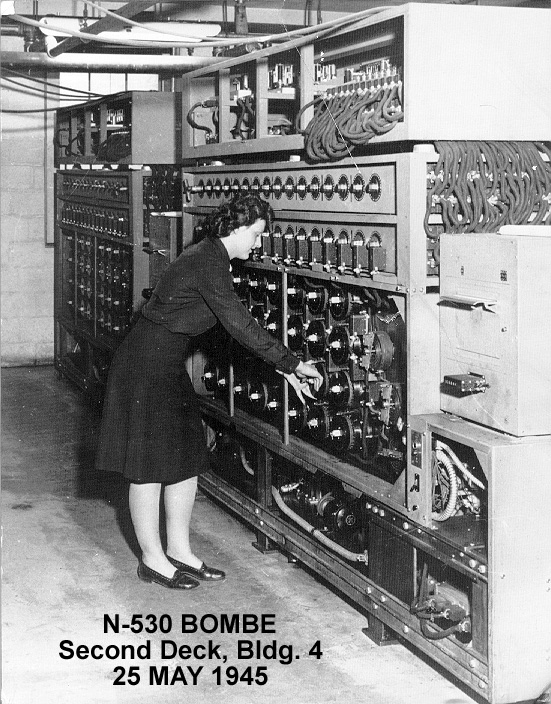September 1, 1943, the first Bombe was shipped to U.S. Navy’s Nebraska Avenue Building in Washington, DC.
A BOMBE was a large electro-mechanical machine used to recover the keys used by German ENIGMA cipher machines. This encryption machine was used by the German armed forces and other governmental agencies. The Navy BOMBES were used for key recoveries of German naval four rotor ENIGMA machines. Once key recoveries were made, it was possible to decipher German naval messages including those to and from U-Boats. This work was done in cooperation with the British cryptanalysis at Bletchley Park, England.
Physically, the BOMBES were about 6 or 7 feet tall, 10 feet wide, and 2 or 3 feet deep, weighed 5,000 pounds, and were mounted on large rollers. On their gray metal faces were two rows of black disks marked 00 to 25 around their circumference with a rotatable brass pointer. Below, there were four rows of eight wheels each. Women Accepted for Volunteer Emergency Service (WAVES) who operated the BOMBES were given a Top Secret (ULTRA) clearance. The cryptanalytic operations were highly compartmentalized and most BOMBE WAVES were not told exactly what they were doing; however, they soon were able to what their very important work was about.
To insure the machines were in properly operating, two WAVES were assigned to work on the sets of four machines to make “machine checks” before and after each operational “run.” If a problem was indicated by a machine check, the WAVE operator would make out a trouble report for the male maintenance watch chief. Maintenance work was then performed by the men. Some WAVES on their own learned to repair circuit boxes located on the sides of the BOMBES.
Operating the BOMBE
Operational menu for setting up a BOMBE were typed by WAVES in the cryptanalytic section and were forwarded to a BOMBE supervisor by pneumatic tube. After the Bombe completed a run, a WAVE supervisor checked the printed results on the M-9 Bombe checker. The supervisor then gave the menu to a BOMBE operator. The menu consisted of instruction to set up the BOMBE wheels, where to place the rotors, and whether a short or long rune was desired. The short run took ten or fifteen minutes. After setting up, the BOMBE was turned on and it would run until a “hit” occurred. The “hit” indicated that an electrical pathway had been found. The BOMBE was running too fast to mechanically record a “hit,” so this was done by an electronic memory circuit. When the machine recorded a “hit,” a brake was automatically applied to stop the drive shaft. A clutch and rewind motor were then engaged to reserve direction until the drive shaft was stopped on the correct “hit” position as indicated by the memory circuit. The rewind effort took only ten to fifteen seconds. While the BOMBE was operating, it would make ticking sound like a clock. It was this ticking sound that gave the machine the name “BOMBE.”
From Encryption to Plaintext
If no “hit” were recorded, the BOMBE would complete its run in 10 to 15 minutes. The resultant “hit” information was recorded by a printer identifying the correct rotor position. The WAVE operators would pass this information through a small door to another supervisor’s room. These recovered keys on the printout were sent back to the cryptanalytic unit by the BOMBE supervisor via pneumatic tube. After the key recovery was confirmed by a cryptanalyst, a WAVE typed out the Germen U-Boat intercepted messages on ENIGMA machine analogues which then produced German plain text.
The plain text was in a continuous stream of German without spaces between words. A Yeoman carried these sheets of paper upstairs to the translator’s office and dropped them into a wire basket. The translators divided the strings of letters into words and translated them into English. Several of the translators were WAVES. One was LT Erminnie Bartelmez, USNR, who had a doctorate in German and LT Marjorie Boynton, USNR. Yeomen, including some WAVES, typed up the handwritten translation and carried them to the watch officers who brought them to the intelligence section. The time between the interception and reporting of decrypted U-Boat messages was eventually measured in hours rather than days.
Many historians believe the work the WAVES and other code-breakers did significantly shortened the war in the Atlantic and the Pacific by more than three years.
Source: NCVA


2 September 2021 at 01:50
Back in the early 1980’s there was an article in Navy Times about the WAVES assigned at Nebraska Ave. being given a stern security lecture that they were never to talk about what they had done there and that if they did, they would be prosecuted. This struck a chord with me because my Mom, also a WAVE but assigned to the Bureau of Yards and Docks had shared an apartment with her sister Phoebe. I remembered Mom saying that Phoebe had been assigned at Nebraska Ave and that after the war had difficulty getting a job back in North Carolina because when she was asked what experience she had, responded that she had been sworn to secrecy and couldn’t talk about what she had done in the Navy. Phoebe was a bit eccentric and based on her own experience working on classified projects Mom thought Phoebe was misinterpreting something she had been told.
I had some knowledge of the Naval Security Group from an OCS classmate and knew that they were on Nebraska Ave. so when I read the article I put two and two together and sent the article on to be parents who sent it on to Mom’s family in North Carolina so we knew that there was a good reason why Phoebe had refused to talk about her service. Also Mom remembered the cuffs of Phoebe’s shirts being dirty so we realized that i was probably from the Bombes.
LikeLike